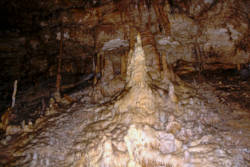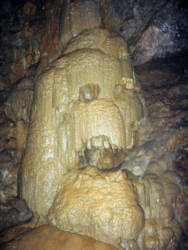ახალი ათონის მღვიმე
Novoafonskaya peschera - Nova Afon Cave - New Afon Cave - New Athos Cave
Useful Information
| Location: |
Novy Afon, Abkhazia.
(43.090643, 40.809982) |
| Open: |
01-JAN to 12-JAN daily 10-18. 13-JAN to APR Wed, Thu, Sat, Sun 10-18. 01-MAY to 11-MAY daily 10-18. 12-MAY to 31-MAY Tue-Thu, Sat, Sun 10-18. JUN daily 10-19. JUL to SEP daily 9-19. OCT to 12-OCT daily 10-18. 13-OCT to OCT Tue-Sun 10-18. NOV to DEC Wed, Thu, Sat, Sun 10-18. [2025] |
| Fee: |
Adults RUR 700, School Pupils RUR 200, Children (0-7) free, Citizens of Abkhazia RUR 200, Students RUR 200, Veterans RUR 200, Photo Permit RUR 50. [2025] |
| Classification: |
 Karst Cave Karst Cave
|
| Light: |
 Electric Light Electric Light
 Coloured Light Coloured Light
|
| Dimension: | L=3,000 m, T=14 °C. |
| Guided tours: | D=90 min, Max=100. V=700,000/a [2000] |
| Photography: | allowed with permit |
| Accessibility: | no |
| Bibliography: | |
| Address: |
New Athos Cave, ახალი ათონის მღვიმე, Chanba St, Akhali Atoni.
Республика Абхазия г. Новый Афон ул. Чанба, 16. E-mail: |
| As far as we know this information was accurate when it was published (see years in brackets), but may have changed since then. Please check rates and details directly with the companies in question if you need more recent info. |
|
History
| 1880s | Novy Afon monastery erected. |
| 1961 | discovered by Givi Smyr. |
| 1963 | 10-day expedition was made into the cave. |
| 1964 | expedition with 21 scientists spends more than four days in the cave. |
| 1971 | beginning of development as a show cave. |
| 1975 | cave opened to the public, railroad constructed. |
| 2005 | first train modernized in Moscow. |
| 2009 | first train modernized in Moscow. |
| 2014 | new train replaces the old trains. |
Description


The ახალი ათონის მღვიმე (New Athos Cave) is the most important tourist cave of Georgia. The actual name of the cave is Афон Ҿыцтәи аҳаҧы, the Abkhazian version of this name. Today Abkhazia is Russian-occupied territory and most of the foreign tourists are Russian, so its most common name is obviously Новоафонская Пещера. The cave was simply named after the town New Athos, where it is located. During its long history the town was previously known as Nikopol, Acheisos, Anakopia, Nikopia, Nikofia, Nikopsis, Absara, and Psyrtskha. The current name is a result of the foundation of the monastery in 1874. The Russian monks from the Rossikon Monastery on Mount Athos feared the outbreak of the Russo-Turkish War, and that as a result the Ottoman Empire would expel the Russian monks from Mount Athos. So they were looking for a new location for their monastery, and chose the small town in the Caucasus, which was called Psyrtskha at that time. During the 1880a a Neo-Byzantine monastery was constructed, dedicated to St. Simon the Canaanite, and named New Athos Monastery. The monastery was funded by Tsar Alexander III of Russia. But the Russian monks were permitted to stay in the "old" Athos, and only a part of the monks came to the new monastery. Nevertheless, the town was renamed. During Soviet times the monastery was closed, and it was reopened in 1994, after the end of the war between Georgia and Abkhazia.
The cave was discovered, explored, and developed as a show cave during the Soviet Era. It is very well developed, with paved paths, bridges, and electric light. Due to its deep entrance shaft it was necessary to create an artificial entrance tunnel. As this tunnel is 1.3 km long, a train was installed which brings visitors through the tunnel into the cave and back. The single track and electrified narrow gauge (914 mm) railway has a third rail, similar to electric model railways. The third rail is the power supply for the trains with 380 V DC, only at switches and at passenger stations there is no third rail and the train runs on 240 V batteries. The train brings visitors from the Входные Ворота (Vkhodnye Vorota, Entrance Gate) to the Зал Апсны (Zal Apsny, Abkhazia Chamber), where the underground walking tour starts. The tour ends Зал Анакопия (Zal Anakopiya, Anakopea Chamber) from where the train returns to the entrance.
Two Ep «Tourist» trains were constructed in 1975 by the Rīgas Vagonbūves Rūpnīca (Railroad Machinery Plants) of Riga in Latvia. In 2005 the first train was modernized in Moscow, in 2009 the second. However, both trains are heavily used and so the management ordered a new train in Riga which was delivered in 2014. The old trains are not used anymore, but they are still in working condition, in case of a malfunction or emergency. All trains have a control car with motor and power equipment and 5 trailer cars for passengers.
The cave is very huge, and six big chambers are developed for the public. The biggest one is the Gruzish Cavers Chamber, which is 260 m long, 75 m wide and up to 50 m high, with an area of 10,635 m² and a volume of 114,250 m³. Abhaziya Chamber is 150 m long, 40 m wide and up to 30 m high. It has an area of 5,710 m² and a volume of 290,875 m³. The main passage of the cave is 1.5 km long.
New Athos Cave is widely renowned for its wealth of speleothems. Beneath stalactites and stalagmites, which are formed of calcite, there are also gypsum crystals of various forms. Crystals resembling little flowers, cover the formation called White Mountain.
There is a legend that the cave was discovered by a shepherd boy in search for a lost sheep in 1965. We have no idea where this story originates, but we guess it’s a joke, told by cave guides when they are bored. The cave entrance was well known to the locals, a 30 m deep daylight shaft which was never entered, and thus called Bottomless Pit. In 1961 a 16-year-old local boy, who was actually quite fit and a good climber, took a simple rope, fixed it at the rim and climbed down. He actually returned and successfully left the cave. The name of this boy was Givi Smyr. This story is a quite common story, which is told at many caves, but typically with a different end. In most cases it’s a story of death or at least accident, and such stunts are generally discouraged by cavers. But he had at least a rope which did not break and was fit enough to leave again.
He returned and told the astonished locals about his discoveries, and soon the info spread. As a result, a team of russian cavers came to the cave, to explore this cave. He explained to them what he discovered, and he accompanied them, now with better gear. The group with eight people climbed down the entrance shaft, and after descending numerous other shafts and steep sections, they reached the main passage at -140 m. The first expedition took 18 hours and discovered a big section of the cave. Survey, and further study of the cave, its microclimate, morphology, geology, mineralogy, and hydrology followed. In 1963 a 10 day expedition was made into the cave. In 1964 an expedition with 21 scientists spent more than four days in the cave. It was a logistic nightmare and 2.5 tonnes of equipment and research instruments were transported in and out of the cave.
Unfortunately, after the collapse of the Soviet Union and with all the internal troubles of Georgia, both Russian and international tourism almost came to an end and the cave had very little visitors. It seems Russian tourism has restarted during the last years, but international tourism is at a low, especially with the current crisis in Ukraine, the area being actually Russian. Still, the cave is one of Georgia’s most popular attractions.
 Crater Names on Asteroid Ida
Crater Names on Asteroid Ida Cave Visits By Tram.
Cave Visits By Tram. Search DuckDuckGo for "Novy Afon Cave"
Search DuckDuckGo for "Novy Afon Cave" Google Earth Placemark
Google Earth Placemark New Athos Cave - Wikipedia (visited: 13-NOV-2021)
New Athos Cave - Wikipedia (visited: 13-NOV-2021) Новоафонская пещера, official website
Новоафонская пещера, official website  (visited: 13-NOV-2021)
(visited: 13-NOV-2021) Index
Index Hierarchical
Hierarchical Countries
Countries Maps
Maps